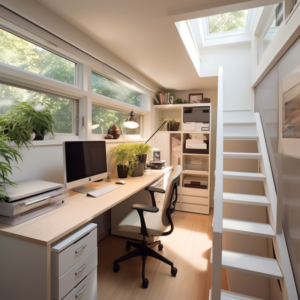As a decorator specializing in office spaces, I understand the importance of creating work environments that are not only aesthetically pleasing but also conducive to productivity and comfort. One key factor that cannot be overlooked is ergonomics. In this article, we’ll explore the fundamental principles of ergonomics and how to design an office that prioritizes comfort and well-being.
1. Understanding Ergonomics:
- Defining ergonomics and its significance in office design.
- The impact of ergonomics on health, productivity, and employee satisfaction.
2. The Ergonomic Chair: A Foundation of Comfort:
- Selecting the right ergonomic chair for your office.
- Proper chair adjustments for optimal support and posture.
3. Desk and Workstation Setup: Creating a Functional Workspace:
- Ideal desk height and positioning for computer work.
- The importance of keyboard and mouse placement.
4. Monitor Placement: Reducing Strain on the Neck and Eyes:
- Proper monitor positioning to prevent neck and eye strain.
- Considerations for dual monitor setups.
5. Lighting and Ergonomics: Illuminating the Workspace:
- The role of lighting in creating an ergonomic office.
- Tips for choosing the right lighting fixtures and placement.
6. Ergonomic Accessories: Enhancing Comfort and Productivity:
- Ergonomic accessories such as keyboard trays and monitor stands.
- The benefits of using an ergonomic footrest.
7. Breakout Areas and Ergonomics: Promoting Movement and Relaxation:
- Designing ergonomic breakout spaces for employees to recharge.
- Incorporating ergonomic furniture for relaxation and collaboration.
8. Ergonomics and Remote Work: Adapting to Changing Work Environments:
- Ergonomic considerations for home offices and remote work.
- Tips for maintaining ergonomics while working from different locations.
9. Employee Training and Ergonomics: Promoting Awareness and Well-Being:
- The importance of educating employees about ergonomics.
- Implementing ergonomic training programs for a healthier workforce.
10. Measuring the Impact: Evaluating Ergonomics in the Office: – Conducting ergonomic assessments and surveys. – Collecting feedback and making continuous improvements.
Conclusion: Incorporating ergonomic principles into office design is not just a trend; it’s a fundamental aspect of creating a comfortable and productive workspace. Prioritizing ergonomics not only enhances employee well-being but also contributes to increased efficiency and job satisfaction. As a decorator, I’m dedicated to helping you achieve a harmonious balance between aesthetics and ergonomics in your office design.



